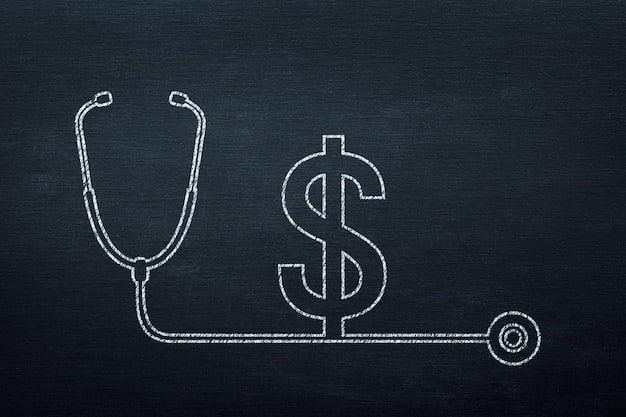Maximize Tax Benefits: 5 Personal Finance Strategies for 2025

Maximize your tax benefits by implementing these 5 personal finance strategies before the end of 2025, including tax-loss harvesting, optimizing retirement contributions, utilizing health savings accounts, charitable giving, and reviewing your investment asset allocation.
Ready to minimize your tax burden and optimize your financial health? Discover these 5 personal finance strategies to implement before the end of 2025 for maximum tax benefits and set yourself up for a financially secure future.
Optimize Your Finances: Tax Strategies for 2025
As the year progresses, it’s crucial to implement strategic financial maneuvers that can significantly impact your tax liabilities. Taking proactive steps can help you reduce your tax burden and improve your overall financial well-being. This guide outlines key strategies that can be implemented by the end of 2025 to maximize your tax benefits.
These strategies not only help in optimizing your tax returns but also contribute to long-term financial stability and growth. By understanding and applying these methods, you can take control of your financial future and ensure a more prosperous outlook.
Understanding Tax Planning
Tax planning involves analyzing your financial situation to ensure tax efficiency. This includes taking advantage of deductions, credits, and exemptions to minimize the amount of tax you owe. Effective tax planning is not a one-time activity but an ongoing process that should be reviewed regularly.
Why Start Early?
Implementing these strategies early allows you to make informed decisions and adjust your financial plan accordingly. Starting early maximizes the potential impact of these strategies, leading to greater tax savings and financial benefits.
- Early Implementation: Starting strategies early in the year allows for better planning.
- Financial Control: Proactive steps give you control over your financial outcomes.
- Long-Term Growth: Many tax-saving strategies also contribute to long-term financial growth.
- Adaptability: Early planning allows for adjustments based on changing circumstances.
In conclusion, taking proactive steps to optimize your finances before the end of 2025 can significantly impact your tax liabilities and contribute to long-term financial well-being. Early implementation, financial control, long-term growth, and adaptability are key reasons to start planning now.
Tax-Loss Harvesting for Investment Gains
Tax-loss harvesting is a powerful strategy for offsetting capital gains taxes. It involves selling investments that have incurred losses to offset gains from profitable investments. This method can significantly reduce your tax liability and improve your investment portfolio’s performance.
Understanding how tax-loss harvesting works and strategically applying it can lead to substantial tax savings. By carefully managing your investment portfolio, you can maximize this benefit and optimize your overall financial strategy.

How Tax-Loss Harvesting Works
The basic principle is to sell losing investments to offset capital gains, thereby reducing your overall tax burden. The losses can first offset any capital gains, and if losses exceed gains, you can deduct up to $3,000 of losses against your ordinary income each year.
Wash-Sale Rule
It’s crucial to be aware of the wash-sale rule, which prevents you from repurchasing the same or substantially identical securities within 30 days before or after the sale. Violating this rule will disallow the tax loss.
- Offsetting Gains: Sell losing investments to reduce capital gains taxes.
- Deductible Losses: Deduct up to $3,000 of losses against ordinary income.
- Wash-Sale Rule: Avoid repurchasing similar securities within 30 days.
- Portfolio Rebalancing: Use tax-loss harvesting as part of a portfolio rebalancing strategy.
In conclusion, tax-loss harvesting is an effective strategy for reducing capital gains taxes by offsetting gains with losses from investments. Understanding the wash-sale rule and using this strategy as part of a portfolio rebalancing plan are crucial for maximizing its benefits.
Maximize Retirement Contributions
Contributing to retirement accounts offers a dual benefit: it helps you save for the future while also potentially reducing your current taxable income. Maximizing your contributions to 401(k)s, IRAs, and other retirement plans can lead to significant tax savings.
Strategic retirement contributions not only secure your financial future but also provide immediate tax benefits. Understanding the contribution limits and plan options can optimize your tax strategy for 2025.
401(k) Contributions
If your employer offers a 401(k) plan, consider contributing up to the maximum allowable amount. For 2024, the contribution limit is $23,000, with an additional $7,500 catch-up contribution for those age 50 and over. These contributions are typically made on a pre-tax basis, reducing your taxable income.
IRA Contributions
Traditional IRAs also offer tax-deductible contributions. For 2024, the contribution limit is $7,000, with an additional $1,000 catch-up contribution for those age 50 and over. Roth IRAs, while not tax-deductible, offer tax-free withdrawals in retirement, providing a different type of tax advantage.
- Pre-Tax Contributions: Reduce your taxable income with 401(k) and traditional IRA contributions.
- Contribution Limits: Stay informed about annual contribution limits to maximize savings.
- Catch-Up Contributions: Take advantage of catch-up contributions if you’re age 50 or older.
- Roth IRA Benefits: Consider Roth IRAs for tax-free withdrawals in retirement.
In conclusion, maximizing retirement contributions is a powerful strategy for both securing your financial future and reducing your taxable income. Staying informed about contribution limits, taking advantage of catch-up contributions if eligible, and understanding the benefits of both traditional and Roth IRAs are crucial for maximizing this strategy.
Utilize Health Savings Accounts (HSAs)
Health Savings Accounts (HSAs) offer a triple tax advantage: contributions are tax-deductible, earnings grow tax-free, and withdrawals for qualified medical expenses are tax-free. If you have a high-deductible health plan (HDHP), contributing to an HSA can be a highly effective tax-saving strategy.
Understanding the benefits and eligibility requirements of HSAs can help you optimize your healthcare spending and reduce your tax burden. This strategy is beneficial for both immediate tax savings and long-term healthcare planning.
HSA Eligibility and Contributions
To be eligible for an HSA, you must be enrolled in a high-deductible health plan and not be covered by any other non-HDHP health insurance. For 2024, the HSA contribution limits are $4,150 for individuals and $8,300 for families, with an additional $1,000 catch-up contribution for those age 55 and over.
Qualified Medical Expenses
HSA funds can be used for a wide range of qualified medical expenses, including doctor visits, prescription drugs, and dental care. Keeping accurate records of these expenses is essential for tax purposes.

- Tax-Deductible Contributions: Reduce your taxable income with HSA contributions.
- Tax-Free Growth: Earnings in an HSA grow tax-free.
- Qualified Expenses: Withdrawals for qualified medical expenses are tax-free.
- Long-Term Savings: HSAs can also be used as a long-term savings vehicle for healthcare expenses.
In conclusion, utilizing Health Savings Accounts (HSAs) offers a triple tax advantage, making it a highly effective strategy for tax savings and healthcare planning. Understanding eligibility requirements, maximizing contributions, and using funds for qualified medical expenses are crucial for optimizing this benefit.
Strategic Charitable Giving
Donating to qualified charitable organizations can provide significant tax deductions. By strategically planning your charitable giving, you can increase your tax savings while supporting causes you care about. Understanding the rules and limits for charitable deductions is essential for maximizing this benefit.
Charitable giving not only supports important causes but also offers potential tax advantages. Applying these strategies can enhance the impact of your donations and optimize your tax planning.
Donating Appreciated Assets
Instead of donating cash, consider donating appreciated assets, such as stocks or mutual funds, that you have held for more than one year. This allows you to deduct the fair market value of the asset and avoid paying capital gains taxes on the appreciation.
Bunching Donations
If your itemized deductions are typically close to the standard deduction amount, consider bunching your donations into a single year. This may allow you to exceed the standard deduction and itemize, resulting in greater tax savings.
- Deduct Fair Market Value: Donate appreciated assets held for more than one year.
- Avoid Capital Gains: Reduce your taxable income by donating assets instead of cash.
- Bunching Strategy: Consolidate donations into a single year to exceed the standard deduction.
- Qualified Organizations: Ensure donations are made to qualified charitable organizations.
In conclusion, strategic charitable giving can provide significant tax deductions while supporting important causes. Donating appreciated assets, bunching donations to exceed the standard deduction, and ensuring donations are made to qualified organizations are crucial for maximizing this benefit.
Review Your Investment Asset Allocation
Regularly reviewing and adjusting your investment asset allocation can help optimize your portfolio for both returns and tax efficiency. Certain asset classes are taxed differently, so strategically allocating your investments can reduce your overall tax burden.
Rebalancing your portfolio not only aligns your investments with your risk tolerance and goals but also provides opportunities for tax optimization. Understanding the tax implications of different asset classes is key to effective tax planning.
Tax-Advantaged Accounts
Hold tax-inefficient assets, such as high-yield bonds or actively managed mutual funds, in tax-advantaged accounts like 401(k)s or IRAs. This shelters the income generated by these assets from current taxation.
Taxable Accounts
In taxable accounts, hold tax-efficient assets, such as stocks or index funds, that generate lower levels of taxable income. This can minimize the tax impact on your investment returns.
- Tax-Efficient Assets: Hold stocks or index funds in taxable accounts.
- Tax-Inefficient Assets: Keep high-yield bonds or actively managed funds in tax-advantaged accounts.
- Rebalancing Strategy: Regularly rebalance your portfolio to maintain your desired asset allocation.
- Long-Term Planning: Align your asset allocation with your long-term financial goals.
In conclusion, reviewing and adjusting your investment asset allocation is crucial for optimizing your portfolio for both returns and tax efficiency. Holding tax-inefficient assets in tax-advantaged accounts and tax-efficient assets in taxable accounts can minimize your overall tax burden. Regularly rebalancing your portfolio and aligning it with your long-term financial goals are also essential steps.
| Key Strategy | Brief Description |
|---|---|
| 📉 Tax-Loss Harvesting | Sell losing investments to offset capital gains taxes. |
| 💰 Maximize Retirement | Contribute fully to 401(k)s and IRAs for tax benefits. |
| ⚕️ Utilize HSAs | Use Health Savings Accounts for tax-deductible medical savings. |
| ❤️ Charitable Giving | Donate appreciated assets for tax deductions. |
Frequently Asked Questions
▼
Tax-loss harvesting involves selling investments at a loss to offset capital gains, reducing your overall tax liability. These losses can first offset any capital gains, and if losses exceed gains, you can deduct up to $3,000 of losses against your ordinary income each year.
▼
For 2024, the 401(k) contribution limit is $23,000, with an additional $7,500 catch-up contribution for those age 50 and over. The IRA contribution limit is $7,000, with an additional $1,000 catch-up contribution for those age 50 and over.
▼
To be eligible for an HSA, you must be enrolled in a high-deductible health plan (HDHP) and not be covered by any other non-HDHP health insurance. You also cannot be claimed as a dependent on someone else’s tax return.
▼
Donating appreciated assets, such as stocks or mutual funds held for more than one year, allows you to deduct the fair market value of the asset and avoid paying capital gains taxes on the appreciation. This can result in significant tax savings.
▼
Rebalancing an investment portfolio involves adjusting the allocation of assets to maintain your desired risk level and investment goals. This often includes selling assets that have performed well and buying assets that have underperformed to bring the portfolio back to its original asset allocation.
Conclusion
Implementing these five personal finance strategies before the end of 2025 can significantly enhance your tax benefits and overall financial well-being. Tax-loss harvesting, maximizing retirement contributions, utilizing health savings accounts, strategic charitable giving, and reviewing your investment asset allocation are all powerful tools for optimizing your financial plan and securing a prosperous future.





